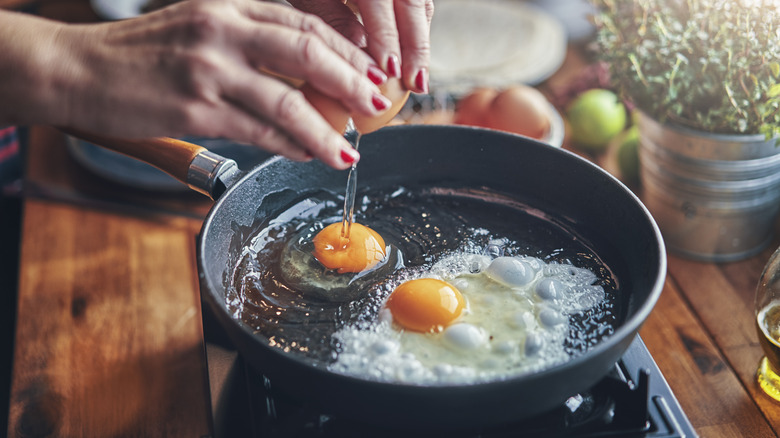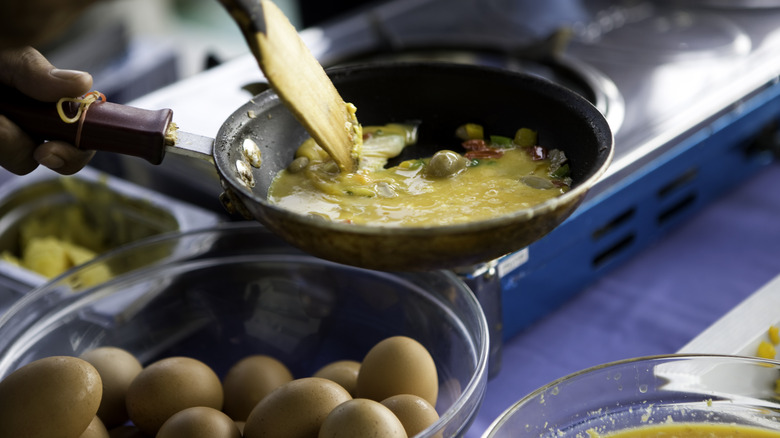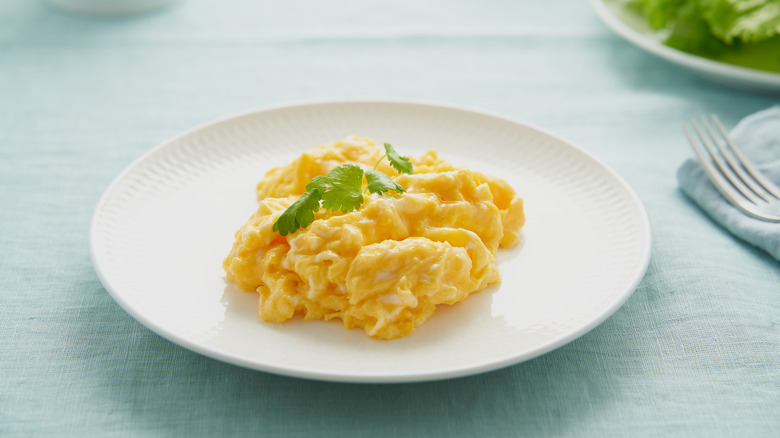Why You Should Always Slightly Undercook Your Eggs
Getting eggs to cook just right is notoriously tough. There's a reason that culinary schools have whole (dreaded) segments of the curricula dedicated to cooking hundreds of them until they're just right! Part of this is because egg whites set at a different temperature than egg yolks, with only a degree of overlap between them. Egg whites set between 141 and 149 degrees Fahrenheit, while egg yolks set between 149 and 158 degrees Fahrenheit (from NDSU Agriculture Communication). Overcooked egg whites become rubbery, while overcooked egg yolks become chalky; the combination of the two can lead to a sulfurous, green tinge. To get perfectly cooked eggs, the answer is somewhat counter-intuitive: You should (slightly) undercook them.
The "slightly" is important. For food safety, scrambled, fried, and basted eggs should always be cooked to a minimum of 144 degrees, per the Egg Safety Center. But with the magic of carry-over cooking, your eggs will continue to rise a few more degrees even after they're removed from the stove. If you've ever made perfect, over-medium eggs and then found that they've gone fully over-hard in the time it takes to move them to the table and eat them, you've experienced this. You can harness this to your benefit. Just take the pan off the heat while the eggs are still a little soft and undercooked, and the heat from the pan and the eggs themselves will finish the cooking process gently and your eggs won't dry out or become rubbery.
Carry-over cooking
Carry-over cooking is the increase in temperature that occurs after the food has been taken off the stove. It's why the ice bath is critical to a good blanche: It stops the carry-over cooking. The second law of thermodynamics helps to explain why carry-over cooking occurs; heat will always "flow" from a hotter area to a colder area. When cooking something like prime rib, this is easy to see. The exterior, in contact with the hot, perhaps 400-degree air of the oven, is going to be hotter than the interior (the part we care about measuring for food safety). The heat will continue to "flow" from the exterior layer to the interior layer as the meat rests, raising the temperature of the interior. Depending on the density of the meat, the cut, and the temperature the exterior reaches, carry-over cooking can raise the internal temperature of meat from four to 19 degrees.
The principle applies to eggs, too: The layer that's been touching the pan and the residual heat from the pan will continue to transition heat to the rest of the egg. Eggs are delicate and very prone to overcooking, so you don't want to let this process happen after the eggs are already done cooking. This is why Gordon Ramsay actually makes eggs by heating the eggs for 90 seconds, taking the pan off the heat for 20 seconds, and repeating this process — the carryover cooking helps moderate the heat for perfect eggs.
Getting eggs just right
The secret to scrambled eggs, as Jamie Oliver tells it, is to "remove them just before they're ready, so that they'll be just right by the time you come to eat them." They still look a bit wet and a bit shiny, but they're definitely not raw. Again, this is important: If your eggs are too undercooked, the slight rise in internal temperature of just a few degrees from carryover cooking will not cook them enough to make them safe to eat.
Once they're off the heat, he piles them in the corner of the pan. This will do two things: It keeps the thermal load of the eggs more constant and it also reduces the surface area of contact between the eggs and the hot pan. This creates an environment of gentle carry-over cooking, letting the eggs come up to the proper temperature for perfect done-ness (149 degrees Fahrenheit for eggs with nothing beaten into them) and giving you some leeway to not overshoot it.
Another great tip is to use a warm plate for your eggs. Regardless of whether you're serving fried eggs, scrambled eggs, or any other preparation, a cold plate will sap the heat out of them. Not only are cold eggs less delicious, but this also stops carry-over cooking in a manner similar to blanching. Warming the serving plate allows for the gentle rise in temperature critical to getting the perfect cook on your eggs.


